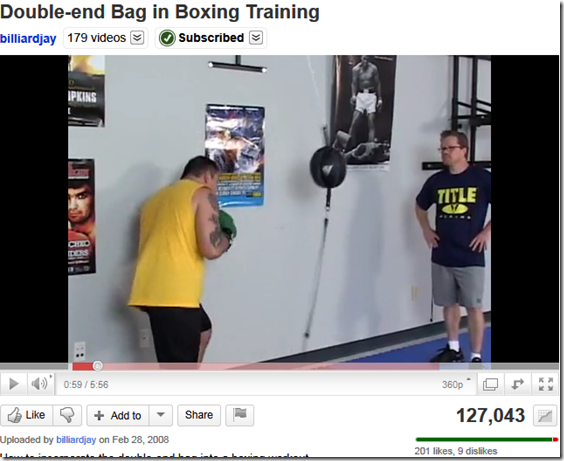
Image credit: Las Vegas Sun
The Double-End Bag is, and should be a staple of training for all striking arts. At about ten or twelve or so years old I was training in Aikido, Taido, and had quite a bit of Taekwondo training, but when I was at home on my own, I was Bruce Lee, Chuck Norris, Muhammad Ali, and, especially Rocky!
After much begging, and some allowance contributions, I obtained my first double-end bag from Asian World, and added it into my training program with no instruction (I did Asian martial arts, and had nothing on boxing except my books and watching Rocky as often as I could!). I quickly learned that contrary to accepted wisdom, some training bags hit back! I learned a lot, developed some skill, and the bag built upon the arsenal of lethal techniques that I already had. It was good!
However, there are more ways to skin a cat, as they say, and many ways to use this tremendous training tool. Here are a few.
Click the photo to view the video (embedding disabled). 
Notice Freddie Roach watching? I guess this has the Freddie seal of approval.
This is the boxing approach. Some highlights of my experience with this approach:
- Use a full, not partial punching motion – don’t “pitty-pat” to get a lot of reps; use the same technique as when you actually punch.
- These punches will produce a backswing, which is your opportunity to slip to avoid getting hit by the bag, and
- That’s your opportunity develop combinations because your body position after slipping and punching will lead to a flow of the natural “next” technique. For example, a 1-2 (jab and straight) will lead to slipping a punch (the bag) over your rear shoulder (the one from the straight punch), and naturally position you for a lead uppercut or hook.
- You’ll get a rhythm in punching and slipping, as you can freelance and slip several times after you’ve thrown a particularly hard punch.
- Hooks will produce a circular motion which you can use to snap-back and hook with the other hand to reverse the motion.
Next, watch Bob Orlando, notable Kuntao, Pentjak Silat, and FMA instructor demonstrate his approach.
Notice that Orlando is using the bag in a different manner.
- In the beginning he demonstrates vertical punches (meaning punching with elbow down, and knuckles lined up vertically), and almost in a Wing Chun chain punch or speed bag manner. This can be a really good exercise in that it will develop accuracy and get you used to impact with the punches. Plus it’s great for building endurance in the muscles used for punching.
- I like how he’s using work gloves – there’s no need to spring for bag gloves with the heavy bag or the timing bag. Had never done that myself, I’ve used 12-18 oz boxing gloves, MMA, bag gloves, or gone au naturel. They all have their advantages. The reason to wear hand protection is that the laces WILL tear up your hands, so be aware.
- Positioning of the bag with regard to the flexible cord – Orlando mentions putting the flex-cord on the top. That, as he says, will allow different movement dynamics. Try both.
In summary, this tool could be used for many purposes, but will definitely add enjoyment, and (in the beginning) challenge to your training. My only advice is to try to consistently train in a manner with your goals – don’t change your style to try to adapt to hitting a bag. Instead, adapt training equipment to your style and needs.
Like this post? Subscribe to our feed or by email and you won’t miss a thing.
Please interact with us at our TDA Training Facebook page!
All original material is copyright of their respective authors.
All rights reserved. Permission must be obtained before use. Copyright 2011


No comments:
Post a Comment